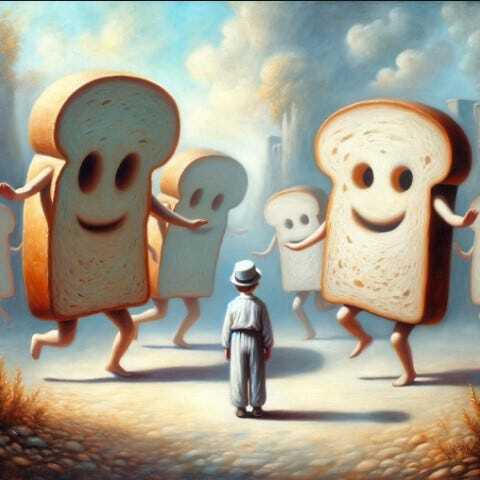The Bun Dance

My mornings start with Wordle, Connections, and the Spelling Bee on the New York Times puzzle app—sometimes ridiculously early. My goal with Spelling Bee is to get to “Genius” level if I can. Later in the day, I might try for “Queen Bee’ if I’m feeling ambitious. And if the hints actually help me.
The other day, I hit '“Genius” without finding the pangram, the word made up of all seven letters in the puzzle—which I find particularly annoying. I went back to the puzzle several times during the day, to see if looking with fresh eyes might reveal something. Eventually, it did, and I found the word “abundance.”
Scenes from a Broken Hand is a reader-supported publication. To receive new posts and support my work, consider becoming a free or paid subscriber.
The funny thing was that, earlier in the day, while messing around with letters to see if I could unlock an idea, I had typed in “bun dance,” and had not seen the real word just sitting there, waiting for me to add the letter “a.”
Sometimes, we see things without actually seeing them.
I thought back to this silliness a few days ago, while running a product workshop with our sales team and talking about aspects of the Science of Reading. A lot of attention has been paid to the need for explicit and systematic instruction in phonemic awareness and phonics in the early grades. This was the focus of Emily Hanford’s excellent podcast series, Sold a Story, which is compelling and disturbing even if you’re not in the ed biz or putting children through school right now. But there are some folks in school districts and state departments of education who seem to be missing the fact that the Science of Reading is not a single thing or a single approach, and that what it requires changes as children get older.
Once students have successfully learned how to read independently, they do not need endless lessons in reading comprehension skills—explicit and systematic instruction, in grade after grade, on things like finding the main idea, identifying supporting details, and using context clues to understand new vocabulary. And yet, that’s what many RFPs and adoption rubrics seem to be demanding—understandably for academic intervention programs, but also, sometimes, for core and supplemental programs. It’s beyond overkill; it’s actually counterproductive.
As Natalie Wexler lays out in her book, The Knowledge Gap, once students know how to read, their reading improves by building knowledge, not abstract, disconnected “skills.” And yet, throughout the country in our elementary schools, ever since the No Child Left Behind Act of 2001, we’ve been pushing science and social studies to the side to make room for generic skills-work within the reading block. Students are reading nonsense—passages that exist only to emphasize a particular skill but not to build any useful knowledge. And they are expected to be able to transfer these free-floating skills to their textbooks and novels, later on. Or perhaps just to their state standardized tests, which is the only kind of reading activity in life that resembles these skills lessons.
The problem is that skills don’t exist in a vacuum; they are context-dependent. If you don’t have a basic grasp of a historical period, you’re going to have trouble applying generic reading skills to historical reading. If you don’t really understand how vaccines work, you’re going to have a lot of trouble, even as an adult, engaging in a debate over the efficacy of a new vaccine during a pandemic—as we all saw, just a few years ago.
E.D. Hirsch pointed this out back in 2006 (earlier, really), by showing how a very simple-to-read sentence could be baffling to readers coming to it without context. Most Americans will have no trouble with a sentence like, “Jones sacrificed and knocked in a run.” But if you know nothing about baseball, you will read the individual words but fail to put them together into an idea. And no worksheets on reading skills can cure that problem. Only access to and experience in the world can.
Even when our curriculum does present students with useful information in the subject areas, it runs the risk of drowning young brains in disconnected facts. Remember, it’s not the facts that matter; it’s the context, or what scientists call the schema, the way we organize discrete information around big ideas. Grant Wiggins used to call it, “contextual Velcro;” the facts you learn are discrete, little balls, but they need a sticky target to hold onto.
This was the whole idea of H. Lynn Erickson’s approach to “concept-based instruction and curriculum.” The facts of a historical period are not important (or memorable) in themselves; they are important to the extent they help us understand something about that period—and, hopefully—our own world. So: if you’re learning about the westward expansion in our country simply because it’s in Chapter 5 and you already finished Chapter 4, that’s not super-compelling (or memorable). But if the information is presented within the context of an engaging question, like, “why do migrants risk everything to move to a new place?” you give students a reason to care about the content. And you can tie that historical period to many others, going all the way back to the story of Abraham in the Bible, and coming all the way up to current debates about immigration reform. This is learning, not only to know and remember, but also to recognize and empathize. This is learning that enmeshes you in a world, rather than leaving you free-floating and confused.
The world is rich and varied and wondrous and strange. Our job as educators is to make sure our students see it in all of its abundance…and not get stymied by a meaningless “bun dance,” that’s almost-but-not-quite what they need.
Scenes from a Broken Hand
- Andrew Ordover's profile
- 44 followers



